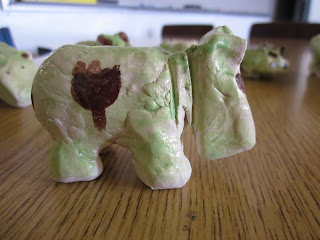My 7th and 8th graders are learning about the famous Mexican artist Pedro Linares Lopez and his paper mache fantasy creatures known as Alebrijes. Last week they designed their own two-dimensional alebrije on paper, and this week they built three-dimensional armatures which will be covered with paper mache next week. After the paper mache has completely dried, they will paint their alebrijes with bright paint and fanciful patterns.
I was amazed at the eagerness and ingenuity that my middle school students displayed during the building stage of this project. It's incredible what one can build with cracker boxes, frozen juice containers, and toilet paper tubes! Check out these legs...dish soap bottles!
A whole entire egg carton for this creature's mouth.
The photo posted above is one that was taken in Mexico City during an annual parade which features alebrijes and is in memory of Pedro Linares. Check back in soon for our completed alebrijes.





















